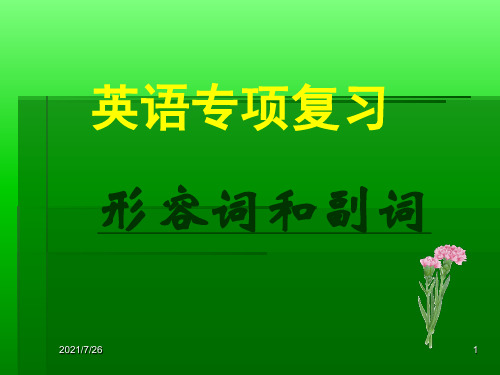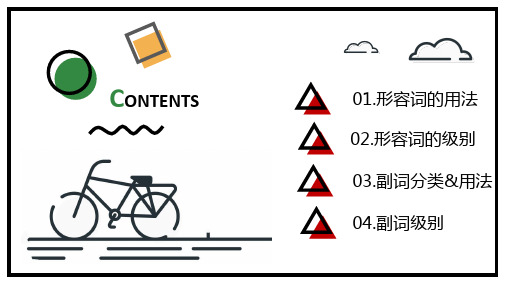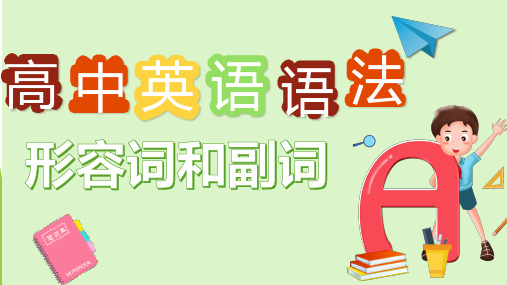形容词副词用法优秀课件
合集下载
初中英语语法——形容词和副词-精(共18张)ppt课件

3
作定语,放在名词之前,不定代词之后
完整最新ppt
4
n ...的人 -al 有...属性的
-ful ...的
-y 充满...的,多...的 -ern ...方位的 -less 无...的
完整最新ppt
-en ...材质的 -able 可能的,可以的
5
副词是一种用来修饰动词,形容 词,副词或全句的词,说明时间,地点, 程度,方式等概念。
比较级
more slowly more quickly more angrily more softly more noisily
最高级
most slowly most quickly most angrily most softly most noisily
由ing分词和ed分词演变过来的形容词(包括不规 则动词如know→known)只能加more或most来表
more更多的;更
less更少的 farther更远的;更远地
further进一步的(地)
most最多的;最
least最少的 farthest最远的;最远地
furthest最深刻的(地)
完整最新ppt
15
①表示两者进行比较时用形容词比较级,其结构为“A…+比较级+ than+B”。 ②有表示程度的副词a little, a bit, a few, a lot, much, even, still, far, rather, any等修饰时,用形容词比较级。 ③表示两者之间进行选择“哪一个更……”时,用句型“Which/ Who is +形容词比较级,A or B?”表示。 ④表示“几倍于……”时,用“倍数+ 比较级+ than”表示。 ⑤表示“两者之间最……一个(of the two)”时,常用“the+比较级”结构。 ⑥表示“越来越……”,用比较级重叠结构,即“比较级+ and +比较级”,多音节词和部分双音节词时用“more and more +形容词原级” ⑦表示“越……就越……”时,用“the+比较级,the+比较级”结构。 ⑧在两者进行比较“表示A不如B”时,部分双音节和多音节副词除使用“not…as/ so +副词原级+as”结构外, 还可使用“less +副词原级+than”结构。 ⑨副词最高级前一般不加定冠词the。
作定语,放在名词之前,不定代词之后
完整最新ppt
4
n ...的人 -al 有...属性的
-ful ...的
-y 充满...的,多...的 -ern ...方位的 -less 无...的
完整最新ppt
-en ...材质的 -able 可能的,可以的
5
副词是一种用来修饰动词,形容 词,副词或全句的词,说明时间,地点, 程度,方式等概念。
比较级
more slowly more quickly more angrily more softly more noisily
最高级
most slowly most quickly most angrily most softly most noisily
由ing分词和ed分词演变过来的形容词(包括不规 则动词如know→known)只能加more或most来表
more更多的;更
less更少的 farther更远的;更远地
further进一步的(地)
most最多的;最
least最少的 farthest最远的;最远地
furthest最深刻的(地)
完整最新ppt
15
①表示两者进行比较时用形容词比较级,其结构为“A…+比较级+ than+B”。 ②有表示程度的副词a little, a bit, a few, a lot, much, even, still, far, rather, any等修饰时,用形容词比较级。 ③表示两者之间进行选择“哪一个更……”时,用句型“Which/ Who is +形容词比较级,A or B?”表示。 ④表示“几倍于……”时,用“倍数+ 比较级+ than”表示。 ⑤表示“两者之间最……一个(of the two)”时,常用“the+比较级”结构。 ⑥表示“越来越……”,用比较级重叠结构,即“比较级+ and +比较级”,多音节词和部分双音节词时用“more and more +形容词原级” ⑦表示“越……就越……”时,用“the+比较级,the+比较级”结构。 ⑧在两者进行比较“表示A不如B”时,部分双音节和多音节副词除使用“not…as/ so +副词原级+as”结构外, 还可使用“less +副词原级+than”结构。 ⑨副词最高级前一般不加定冠词the。
形容词和副词(共19张PPT)

04
形容词和副词的特殊用法
形容词的特殊用法
形容词作名词
形容词的比较级和最高级
某些形容词可以作为名词使用,如“ 幸福”、“成功”等,表示一种状态 或结果。
形容词有比较级和最高级的用法,用 于描述程度或数量的差异,如“更快 ”、“最高”等。
形容词修饰名词
形容词可以放在名词前面,用来描述 名词的特征或属性,如“美丽的花朵 ”、“高大的建筑”等。
详细描述
副词用于描述动词、形容词或其他副词的行为方式、程度、时间、频率等,对于准确表达动作或状态的细节至关 重要。通过副词选择题,可以练习副词在不同语境中的用法,如描述动作发生的时间、方式、频率等,判断副词 的正确用法和意义。
综合练习
总结词
提高综合运用形容词和副词的能力
详细描述
综合练习是将形容词和副词结合在一起使用的练习方式,通过设置语境和情境,让学生根据上下文选 择合适的形容词和副词,以增强学生对形容词和副词的理解和应用能力。综合练习可以包括填空、改 错、翻译等形式,让学生在实际运用中提高对形容词和副词的掌握程度。
副词的比较级和最高级
副词的比较级
用于描述动作、状态或方式在两个或更多的人或事物之间的 相对差异。通常在副词后加“-er”或“more + 副词原形” 构成比较级。例如,“faster”和“more beautifully”。
副词的最高级
用于描述动作、状态或方式在三个或更多的人或事物中的最 高或最低程度。通常在副词后加“-est”或“most + 副词原 形”构成最高级。例如,“fastest”和“most beautifully”。
THANK YOU
ห้องสมุดไป่ตู้感谢各位观看
表示动作的程度,如“very”、 “too”、“quite”、“almost”等 。
初中英语语法—形容词、副词 PPT课件 图文

A. correct B. correctly C. correctness D. correcting
5. They watched a movie and felt quite __A___ .
A. sad B. sadly C. sadness D. sady
形容词作宾语补 足语
某些动词如make,paint,keep,find, like,want等后接名词或代词作宾语,再接 形容词作宾语补足语,补充说明宾语的状态、 特征等。形容词和宾语一起构成复合宾 语.有的已构成固定词组。
an old big brown wooden box 一个旧而大的棕色木箱子 two tall young Japanese girls 两位高个、年轻的日本姑娘
例题
1) Tony is going camping with ___ boys. A. little two other B. two little other C. two other little D. little other two
1.He is a good student. 2. She is a beautiful girl. 3. I have a clever pet dog.
2)多个形容词做定语时的排列顺序:
口诀: 冠代数形大,新色国材名
注释: 冠----冠词;代----代词;数----数词;形----形状、 性质;大----大小、长短;新----新旧;色----颜色; 国----国家、产地;材----材料、用途;名-----名词
The windows of our classroom are cleaner than those of theirs.
形容词原级的常用句
5. They watched a movie and felt quite __A___ .
A. sad B. sadly C. sadness D. sady
形容词作宾语补 足语
某些动词如make,paint,keep,find, like,want等后接名词或代词作宾语,再接 形容词作宾语补足语,补充说明宾语的状态、 特征等。形容词和宾语一起构成复合宾 语.有的已构成固定词组。
an old big brown wooden box 一个旧而大的棕色木箱子 two tall young Japanese girls 两位高个、年轻的日本姑娘
例题
1) Tony is going camping with ___ boys. A. little two other B. two little other C. two other little D. little other two
1.He is a good student. 2. She is a beautiful girl. 3. I have a clever pet dog.
2)多个形容词做定语时的排列顺序:
口诀: 冠代数形大,新色国材名
注释: 冠----冠词;代----代词;数----数词;形----形状、 性质;大----大小、长短;新----新旧;色----颜色; 国----国家、产地;材----材料、用途;名-----名词
The windows of our classroom are cleaner than those of theirs.
形容词原级的常用句
最新课件形容词和副词的用法PPT课件

She studies much harder. 4. 表示可能性的副词或表示真实性有多大
的副词,通常不用于句末。(probably, possibly, certainly, definitely )
They have probably gone there.
5. 副词修饰全句时的位置
⑴大多数修饰全句的副词可以置于句首,句中或 句末,多用逗号和其他部分隔开。
形容词和副词
▪ 1概述;形容词和副词都是起修饰作用的词类。 形容词主要修饰名词和代词,副词主要修饰动 词,形容词或其他副词,有时也可以修饰全句。
▪ 2. 形容词的句法功能,构成,在句子的作用, 位置。
▪ 3. 副词的分类,构成,在句子中的作用,位置。
▪ 4. 形容词和副词的原级,比较级,最高 级,无比较级的形容词和副词。
The door is two meters high.
The room is形容词作定语时的排列顺
序
如有一个以上的形容词修饰名词,这些形容词的位 置即由它们和被修饰名词的关系的密切程度来决 定。一般说来,关系最密切的最靠近被修饰的名 词(中心词),关系较远的离被修饰的名词也较 远,但这个顺序也是有规则可循的,一般为;
系动词,情态动词后。
She always goes to school at seven. He has never been to shanghai.
3. 程度副词(enough除外一般放在被修饰 的形容词,副词,动词前。
This is a very good book
I quite understand.
限定词(these,those...)+数量形容(three)+描 绘性形容词(beautiful)+大小、短,高低等形体性 形容词(large,long,high)+新旧(old)+颜色 (red)+国籍(Chinese)+材料(wood)+用途 (writing)+被修饰名词(desk)。如
的副词,通常不用于句末。(probably, possibly, certainly, definitely )
They have probably gone there.
5. 副词修饰全句时的位置
⑴大多数修饰全句的副词可以置于句首,句中或 句末,多用逗号和其他部分隔开。
形容词和副词
▪ 1概述;形容词和副词都是起修饰作用的词类。 形容词主要修饰名词和代词,副词主要修饰动 词,形容词或其他副词,有时也可以修饰全句。
▪ 2. 形容词的句法功能,构成,在句子的作用, 位置。
▪ 3. 副词的分类,构成,在句子中的作用,位置。
▪ 4. 形容词和副词的原级,比较级,最高 级,无比较级的形容词和副词。
The door is two meters high.
The room is形容词作定语时的排列顺
序
如有一个以上的形容词修饰名词,这些形容词的位 置即由它们和被修饰名词的关系的密切程度来决 定。一般说来,关系最密切的最靠近被修饰的名 词(中心词),关系较远的离被修饰的名词也较 远,但这个顺序也是有规则可循的,一般为;
系动词,情态动词后。
She always goes to school at seven. He has never been to shanghai.
3. 程度副词(enough除外一般放在被修饰 的形容词,副词,动词前。
This is a very good book
I quite understand.
限定词(these,those...)+数量形容(three)+描 绘性形容词(beautiful)+大小、短,高低等形体性 形容词(large,long,high)+新旧(old)+颜色 (red)+国籍(Chinese)+材料(wood)+用途 (writing)+被修饰名词(desk)。如
形容词和副词用法总结.ppt课件

2021/7/26
8
as+形容词原形/副词原级+as
Tom is as tall as Mike. Tom is three times as old as Mike. There are as many students in our school as yours. If you work hard ,you can get as much money as possible
2021/7/26
17
…one of the+最高级+名词复数 Lu Xun is one of the greatest writers l. …最高级+of (in)…
Of all the movie stars, I think Zhang Ziyi is the best. Jim is the tallest boy in our class. 表示三者及三者以上之间的选择,可使用 “Which is+ 最高级,A ,B orC…?”
A.very delicious B. much delicious C. more delicious D. as delicious
2. Lin Tao jumped __C__ in the long jump
in the school sports meeting . A. far B. farther C. farthest D. quite far
C. much stronger D. the strongest
9. Li lei often talks __A___ but does _____ so
everyone says he is a good boy.
英语形容词和副词ppt课件

He made us happy.
做状语
作状语,表示伴随、原因、结果等。
eg.He went to bed , cold and hungry .
She后置:
A. 修饰some, any, no, every 等构成的复合不定代词要后置。 something new; nothing serious; anything interesting
PART TWO
形容词级别
1.规则形容词的比较级和最高级(4种)
⑴直接加-er , -est :
young
clever
brave
younger cleverer
braver
youngest cleverest
bravest
⑵辅音字母 + y 结尾的变 y 为 i 再加 -er、-est :
happy
B.interesting,be interested
C. interested; be interesting D. interesting; interest
3.I’m very_____ on hearing the_______ news.
A.surprised, surprising B.surprising, surprised
............的
1.通常放在名词之前
a blue cap
a big orange
形容词既可修饰单数也可修饰复数
a red strawberry three red strawberries
2.可以放在 be 动词之后 This suit is yellow. These suits are yellow. The apple is red . The apples are red .
做状语
作状语,表示伴随、原因、结果等。
eg.He went to bed , cold and hungry .
She后置:
A. 修饰some, any, no, every 等构成的复合不定代词要后置。 something new; nothing serious; anything interesting
PART TWO
形容词级别
1.规则形容词的比较级和最高级(4种)
⑴直接加-er , -est :
young
clever
brave
younger cleverer
braver
youngest cleverest
bravest
⑵辅音字母 + y 结尾的变 y 为 i 再加 -er、-est :
happy
B.interesting,be interested
C. interested; be interesting D. interesting; interest
3.I’m very_____ on hearing the_______ news.
A.surprised, surprising B.surprising, surprised
............的
1.通常放在名词之前
a blue cap
a big orange
形容词既可修饰单数也可修饰复数
a red strawberry three red strawberries
2.可以放在 be 动词之后 This suit is yellow. These suits are yellow. The apple is red . The apples are red .
高中英语语法:形容词和副词(共61张PPT)

一、形容词和副词的句法功能
1.作定语 形容词作定语一般位于被修饰词的前面;副词作定语多表示时间 或地点,位于被修饰词的后面。 Widespread poverty in Africa means that many people there cannot get the water, clothing, housing, electricity, or education they need.非 洲普遍的贫穷意味着那里的许多人不能获得他们需要的饮用水、 衣服、房屋、电力及教育。 The people there were friendly.那儿的人很友好。(副词作定语须 后置)
the English英国人
(2)“the+形容词”表示抽象概念,作主语时谓语动词用单数。
the best最好的情况
the unknown未知的事
the impossible不可能的事
the right正确的事
二、形容词和副词的位置
1.形容词的位置 (1)一般情况下,单个形容词都位于所修饰的名词前。
一二、介 形词 容的 词分 和类副词的位置
(3)形容词也可位于被修饰名词之后。
③两个意义相近或相反的形容词用and, or或but连接,作定语时须后 置。 Power stations, large or small, have been set up all over the country.大大 小小的发电站已经在全国建立起来了。 All the people on this island, young or old, are fond of music.这个岛上的 老老少少都喜欢音乐。(意义相反。) ④当“形容词+不定式”构成的短语作定语时。 A man so difficult to please must be hard to work with.一个如此难以取悦 的人一定很难共事。 He enjoys the music pleasant to listen to.他很喜欢这首听起来很好听的 音乐。
形容词和副词英语语法讲解PPT

个句子。如:
• He had worked hard all his life .(修饰动词) • He is very diligent.(修饰形容词)
• You can find books on that subject quite easily .(修饰副词)
• Luckily she was in when I called .(修饰句 子)
比较级 1. 构成形式: - er
注意不规则变化
原级
比较级
much/many more ill/bad/badly worse
little
less
good / well better
far
farther
st worst least best farthest furthest
1.She doesn’t speak_A__ her friends, but her written work is excellent.
1.This ____A___ girl is Lind’s cousin.
A. pretty little Spanish
B. Spanish little pretty
C. Spanish pretty little D. little pretty Spanish
2. One day they crossed the __A__bridge behind the palace.
E. 某些形容词,如: present (在场的,出席的), involved(有关的), concerned (相关的), left (剩下 的), mentioned (提及的), selected (当选的)等。 如: the students present (出席的学生)
• He had worked hard all his life .(修饰动词) • He is very diligent.(修饰形容词)
• You can find books on that subject quite easily .(修饰副词)
• Luckily she was in when I called .(修饰句 子)
比较级 1. 构成形式: - er
注意不规则变化
原级
比较级
much/many more ill/bad/badly worse
little
less
good / well better
far
farther
st worst least best farthest furthest
1.She doesn’t speak_A__ her friends, but her written work is excellent.
1.This ____A___ girl is Lind’s cousin.
A. pretty little Spanish
B. Spanish little pretty
C. Spanish pretty little D. little pretty Spanish
2. One day they crossed the __A__bridge behind the palace.
E. 某些形容词,如: present (在场的,出席的), involved(有关的), concerned (相关的), left (剩下 的), mentioned (提及的), selected (当选的)等。 如: the students present (出席的学生)
形容词和副词的用法大全PPT课件

Revision
1.Do sports every day to healthy keep______h(ehaevaillth). 2.It snowedy____h_e_a(vhyeavy) yesterday. 3.The rain wsiullnbney______(heavy) in some places.
第18页/共42页
More examples: 1.He is the youngest of all the children. 2.This book is the most interesting of all books. 3.America is the most developed country in the world.
broken 4. It will be _____(sun) tomorrow. 5.Her pen was _______(break).
第1页/共42页
一、形容词和副词的概念
形容词:是修饰名词(人或事物),表示名 词的性质,特征或属性一种词类。 它在句中作定语、表语和宾语补足
语。 副词:用来修饰动词、形容词及其他副词
_h_e_a_v_i_e_st_____________
_m_o_s_t_d_e_li_c_io_u_s_________ __m__o_s_t _______________
第17页/共42页
比较级的用法: …than… 1.汤姆比杰克高. Tom is taller than Jack. 2.这只箱子要比那只箱子大.
2.She looks fine. 3.They turn green.
第3页/共42页
③如果形容词修饰不定代词something, anything, everything, nothing等时,要放在不定 代词后面。 如:something interesting nothing new + else 修饰不定代词和疑问代词时,要后置。 如:
1.Do sports every day to healthy keep______h(ehaevaillth). 2.It snowedy____h_e_a(vhyeavy) yesterday. 3.The rain wsiullnbney______(heavy) in some places.
第18页/共42页
More examples: 1.He is the youngest of all the children. 2.This book is the most interesting of all books. 3.America is the most developed country in the world.
broken 4. It will be _____(sun) tomorrow. 5.Her pen was _______(break).
第1页/共42页
一、形容词和副词的概念
形容词:是修饰名词(人或事物),表示名 词的性质,特征或属性一种词类。 它在句中作定语、表语和宾语补足
语。 副词:用来修饰动词、形容词及其他副词
_h_e_a_v_i_e_st_____________
_m_o_s_t_d_e_li_c_io_u_s_________ __m__o_s_t _______________
第17页/共42页
比较级的用法: …than… 1.汤姆比杰克高. Tom is taller than Jack. 2.这只箱子要比那只箱子大.
2.She looks fine. 3.They turn green.
第3页/共42页
③如果形容词修饰不定代词something, anything, everything, nothing等时,要放在不定 代词后面。 如:something interesting nothing new + else 修饰不定代词和疑问代词时,要后置。 如:
形容词副词的用法公开课获奖课件

The football game was marvelous.(表语)足球赛精彩极了。 I'm sorry that I'm late.(表语) 对不起,我迟到了。 Don't leave the door open, please.(宾补) 请不要将门敞着。 He spent three days in the snow, cold and hungry. (状语) 他又冷又饿地在风雪中过了两天。
不过不可以说:*The nonsense is utter. 可以说:This child is asleep. 不过不可以说:*This is an asleep child.
第6页
形容词, 就其词汇意义来说,有可分为静态形容词和 动态形容词。静态形容词描绘人和物静态特性,如tall, short, big, small, shallow, deep, ugly, beautiful, solid, liquid等。大多数形容词都是静态,但也有少数带有 动作含义,这部分形容词叫做动态形容词,如 abusive, adorable, calm, cheerful, placent, dull, faithful, generous, gentle, hasty, impudent, irritable, irritating, jealous, lenient, loyal, mischievous, nice, noisy, obstinate, playful, reasonable, rude, sensible, shy, slow, suspicious, tidy, timid, troublesome, untidy, unscrupulous, vicious, vain, vicious等。
不过不可以说:*The nonsense is utter. 可以说:This child is asleep. 不过不可以说:*This is an asleep child.
第6页
形容词, 就其词汇意义来说,有可分为静态形容词和 动态形容词。静态形容词描绘人和物静态特性,如tall, short, big, small, shallow, deep, ugly, beautiful, solid, liquid等。大多数形容词都是静态,但也有少数带有 动作含义,这部分形容词叫做动态形容词,如 abusive, adorable, calm, cheerful, placent, dull, faithful, generous, gentle, hasty, impudent, irritable, irritating, jealous, lenient, loyal, mischievous, nice, noisy, obstinate, playful, reasonable, rude, sensible, shy, slow, suspicious, tidy, timid, troublesome, untidy, unscrupulous, vicious, vain, vicious等。
- 1、下载文档前请自行甄别文档内容的完整性,平台不提供额外的编辑、内容补充、找答案等附加服务。
- 2、"仅部分预览"的文档,不可在线预览部分如存在完整性等问题,可反馈申请退款(可完整预览的文档不适用该条件!)。
- 3、如文档侵犯您的权益,请联系客服反馈,我们会尽快为您处理(人工客服工作时间:9:00-18:30)。
形容词副词用法优秀课件
一.形容词
1.掌握下列名词和形容词的转化
• sun - sunny friend – friendly
• care - careful wind - windy
• rain - rainy
use - useful
• cloud- cloudy
•
2.表语形容词:
afraid 害怕的
Read and compare :
younger longer
youngest longest
fuller shorter smaller older
finer
fullest shortest smallest
oldest
finest
easier hungrier earlier heavier
easiest hungriest
副词的构成
有许多副词是对应的形容词加ly构成,如:
strong -- strongly real -- really 词尾是y的要把y变为i再加 ly, busy -- busily happy -- happily 以e结尾的,大部分直接加-ly, wide –widely late - - lately 有几个特殊的要去e后再加-ly或y, true -- truly terrible--terribly
worse more exciting more carefully
worst most exciting most carefully
He runs fast.
I found him outside.
规则变化
• 1.单音节和少数双音节单词,一般在词 尾加“er”或“est”。
• clean, tall, small, cheap , short, long, light, high
• 2. 以不发音字母“e”结尾的单词,直接 在词尾加 “r”或“st”。
记忆口诀:
合二为一共三对,“坏bad”,“病ill”,两多 many/much”和“两好good/well”,
一分为二只两个,一是“远far”来二是 “老old”,
还有一词little含双义,只记“少”来不记 “小”。
young long full short small old fine easy hungry early heavy big red
The girl thIs your brother in ?(作表语) • 3.有些副词(rather、quite等)通常可以防在名词 前用于加强语气.
用法 作表语 作定语 作状语 作宾补
例
句
My mother is out .
The girl there is my friend .
The work is difficult. She looks happy today. Please keep the room clean. I find it very beautiful.
形容词作定语时 放在被修饰词之 前,修饰不定代 词放在后面
作表语与系动 词连用
• 副词的分类
• 时间副词 now,before, lately, tonight • 地点副词 here, there, somewhere • 频率副词 always, often, usually, seldom • 程度副词 very, rather, quite, enough • 方式副词 quickly, carefully, calmly • 方向副词 forward, backward • 疑问副词 when, where, how, why • 连接副词 when, where, why ,how
• 副词的用法
• 1.主要用作状语,修饰动词、形容词、副词,还可 以修饰介词短语和句子。
I have already prepared my lesson.(修饰动词) He has been extremely busy these days.(修
饰形容词) • 2.也可以用作表语或定语,作定语时通常后置.
• alone 单独的 • asleep 睡着的 • fine 健康的
alive 活着的
ashamed 羞愧的 awake 醒着的 ill有病的
3.以ly结尾的形容词:
• 1)大部分形容词加-ly可构成副词。但 friendly,deadly,lovely,lonely, likely,lively, ugly,brotherly, 仍为形容词。 2)有些以-ly 结尾既为形容词,也为副词。 daily,weekly,monthly,early, early
earliest heaviest
bigger redder
biggest reddest
healthy many famous ill exciting carefully wet hot little few
healthier
healthiest
more
most
more famous most famous
“y”为“i”,在加“er”或“est”。
5. happy , easy, heavy, healthy, busy,
lucky, pretty, sunny, funny
5. 其他双音节单词和多音节单词,都在其前 面加“more”或“most”。(beautiful, interesting)
6. 不规则变化。
• nice, late, close, fine, large, free, rude
3. 以重读闭音节结尾的单词,如果词尾 只有一个辅音字母时,应先双写这一 辅音字母,再加“er”或“est”。
4. fat, big, red, thin, hot, fat, sad,
5. wet 4. 以辅音字母+y结尾的单词,应先改
The Times is a daily paper.
The Times is published daily.
4、形容词的用法
用法
例句
补充说明
作定 语
作表 语 作宾 补
This is an interesting book. I have nothing important to tell you.
一.形容词
1.掌握下列名词和形容词的转化
• sun - sunny friend – friendly
• care - careful wind - windy
• rain - rainy
use - useful
• cloud- cloudy
•
2.表语形容词:
afraid 害怕的
Read and compare :
younger longer
youngest longest
fuller shorter smaller older
finer
fullest shortest smallest
oldest
finest
easier hungrier earlier heavier
easiest hungriest
副词的构成
有许多副词是对应的形容词加ly构成,如:
strong -- strongly real -- really 词尾是y的要把y变为i再加 ly, busy -- busily happy -- happily 以e结尾的,大部分直接加-ly, wide –widely late - - lately 有几个特殊的要去e后再加-ly或y, true -- truly terrible--terribly
worse more exciting more carefully
worst most exciting most carefully
He runs fast.
I found him outside.
规则变化
• 1.单音节和少数双音节单词,一般在词 尾加“er”或“est”。
• clean, tall, small, cheap , short, long, light, high
• 2. 以不发音字母“e”结尾的单词,直接 在词尾加 “r”或“st”。
记忆口诀:
合二为一共三对,“坏bad”,“病ill”,两多 many/much”和“两好good/well”,
一分为二只两个,一是“远far”来二是 “老old”,
还有一词little含双义,只记“少”来不记 “小”。
young long full short small old fine easy hungry early heavy big red
The girl thIs your brother in ?(作表语) • 3.有些副词(rather、quite等)通常可以防在名词 前用于加强语气.
用法 作表语 作定语 作状语 作宾补
例
句
My mother is out .
The girl there is my friend .
The work is difficult. She looks happy today. Please keep the room clean. I find it very beautiful.
形容词作定语时 放在被修饰词之 前,修饰不定代 词放在后面
作表语与系动 词连用
• 副词的分类
• 时间副词 now,before, lately, tonight • 地点副词 here, there, somewhere • 频率副词 always, often, usually, seldom • 程度副词 very, rather, quite, enough • 方式副词 quickly, carefully, calmly • 方向副词 forward, backward • 疑问副词 when, where, how, why • 连接副词 when, where, why ,how
• 副词的用法
• 1.主要用作状语,修饰动词、形容词、副词,还可 以修饰介词短语和句子。
I have already prepared my lesson.(修饰动词) He has been extremely busy these days.(修
饰形容词) • 2.也可以用作表语或定语,作定语时通常后置.
• alone 单独的 • asleep 睡着的 • fine 健康的
alive 活着的
ashamed 羞愧的 awake 醒着的 ill有病的
3.以ly结尾的形容词:
• 1)大部分形容词加-ly可构成副词。但 friendly,deadly,lovely,lonely, likely,lively, ugly,brotherly, 仍为形容词。 2)有些以-ly 结尾既为形容词,也为副词。 daily,weekly,monthly,early, early
earliest heaviest
bigger redder
biggest reddest
healthy many famous ill exciting carefully wet hot little few
healthier
healthiest
more
most
more famous most famous
“y”为“i”,在加“er”或“est”。
5. happy , easy, heavy, healthy, busy,
lucky, pretty, sunny, funny
5. 其他双音节单词和多音节单词,都在其前 面加“more”或“most”。(beautiful, interesting)
6. 不规则变化。
• nice, late, close, fine, large, free, rude
3. 以重读闭音节结尾的单词,如果词尾 只有一个辅音字母时,应先双写这一 辅音字母,再加“er”或“est”。
4. fat, big, red, thin, hot, fat, sad,
5. wet 4. 以辅音字母+y结尾的单词,应先改
The Times is a daily paper.
The Times is published daily.
4、形容词的用法
用法
例句
补充说明
作定 语
作表 语 作宾 补
This is an interesting book. I have nothing important to tell you.
